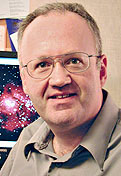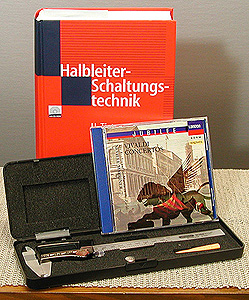|
||||

 Daily Notebook
Daily Notebook






|
|
2008 December 31 |
A well-thought-out light dimmer
Not so the Lutron Glyder that we installed. It goes smoothly from full brightness to a very dim orange glow. A separate button allows the light to be turned on or off at any setting. I'm guessing they're using a microprocessor to time the appropriate portion of each AC cycle. Now that microprocessors cost 50 cents or less, that's how I would have done it. Next year's Daily Notebook will begin with some astrophotos that I've been meaning to process. As 2008 draws to a close, I wish you all a happy and prosperous new year. |
|
|
|
2008 December 29-30 |
A nebula filter that mounts inside the camera I've bought myself an Astronomik CLS nebula filter that mounts inside the Canon camera body behind the lens and ahead of the mirror. It fits into the space that is occupied by EF-S but not EF lens mounts. Then you can use EF lenses (including T-adapters and lens converters) but not EF-S lenses (the special smaller lenses for Canon small-format DSLRs). This is a dichroic filter that passes the wavelengths of nebulae but blocks (as far as possible) mercury and sodium streetlights. Mounted in the camera, it has the nice side effect that it keeps dust off the sensor. In fact, Astronomik makes a clear filter for just that purpose. Canon DSLR users, take note. I tested it with a Canon EOS 20Da camera and a Sigma 105-mm f/2.8 lens (with crosshairs in front) wide open. Here's a stack of four 5-minute exposures:
That's not a very well-processed image; I'm showing you the full frame to show that, like other dichroic filters, this one transmits slightly the wrong colors off-axis (away from the center). Note the greenish center and bluish edges. But some of the purple at the upper left includes red light from a real nebula, Barnard's Loop. With my 300-mm lens, the light rays reaching the filter will be more nearly parallel and I don't expect to see a color shift from center to edge. Of course, what really matters is the exit pupil distance of the lens, not the focal length, and it may also help to stop the lens down; the instructions point out that the filter was not designed to work at f/2.8. Now for the fully processed picture, from the center of the image. Below you see the Belt and Sword of Orion. This was taken under city skies with a magnitude limit of 4.5. Not too bad!
Dark and flat frames were applied and the image was adjusted with MaxIm DL and Photoshop CS3. No grain removal was performed. |
|
|
|
2008 December 28 |
Miscellany I've added more items to the eBay sale. Click here and here. Where else can you get a Ford cupholder, a microscope stand, and a semi-defunct laptop, all from the same vendor? The first autofocus camera was demonstrated by Canon at Photokina 1963, 45 years ago. Practical autofocus cameras didn't reach the market until the 1980s, though. Don't confuse autofocus with "fixed focus" — lots of older, simple cameras didn't need focusing because their focus could not change; they could only photograph distant objects. That's why people's snapshots didn't include intimate full-face portraits until the SLR era. You might imagine that a giant snow globe (water ball with figurines and fake snow inside) might act as a burning glass when sunlight hit it, and if that's what you imagined, you'd be right. Cough, sniffle... I know I'm an efficient worker, but this year I seem to have managed to have influenza (complete with high fever) for just 18 hours, preceded and followed by a very bad cold. Maybe the flu shot helped, or maybe it wasn't influenza. |
|
|
|
2008 December 27 |
Over to eBay... I'm cleaning out the cabinets and will be listing several electronic items on eBay. Click here and beat a path to my door... Come back in a few hours to see what else has been listed. Update: The eBay sale is, or will very soon be, in two parts for tax reasons (business and personal property). To see the second part, click here. |
|
|
|
2008 December 26 |
Christmas goodies
Melody, Cathy, Sharon, and I had a good Christmas at home, giving each other presents that were carefully selected to be useful and (in some cases) amusing. For example, I gave Sharon a coffee mug made from a 400-mL Pyrex beaker; the University's glassblowing shop makes these (by attaching the handle) for coffee drinkers who like a scientific atmosphere. Three of the things I was given are particularly worth recommending to others. Cathy's friend Nathaniel Barrett gave me a CD of Vivaldi concertos performed by the Academy of St. Martin-in-the-Fields. Highly recommended. Both the performance and the recording quality are much better than on other CDs of the same works. In particular, the recording lacks the unpleasant squeaky quality that has bothered me in other recent recordings of violin works. Melody gave me a General Tools digital caliper which has a couple of civilized features that other digital calipers lack. It turns on automatically when you change the separation, and it turns off automatically after a few minutes, saving the battery. What's more, it reads in fractions of an inch (to the nearest 1/64) as well as decimal inches and millimeters. Fundamental accuracy is 0.02 mm, which is quite impressive considering it's not a micrometer. Finally, as a present to myself, I bought a big German electronics book, Tietze and Schenk's Halbleiter-Schaltungstechnik. (Yes, I read things like this for enjoyment.) Language cowards can also get it in English, but I like a challenge. Basically, this is a sequel to Horowitz and Hill's The Art of Electronics, with more theory and fewer ready-to-use circuits. The authors have thought carefully about everything, and their approach often includes fresh ideas. For example, most books tell you about only one kind of op-amp (voltage input, voltage output); this one takes you through the other three (voltage input, current output; current input, voltage output; and current input, current output) and tells you about ICs that use them. (One language pitfall got me: Nachrichtentechnik means "communications technology," not "news technology" as I first thought. I wondered why they were boasting about a new section on journalism...) |
|
|
|
2008 December 24-25 |
This isn't one of my astrophotos, of course. It's NASA's famous image from 40 years ago today. In December, 1968, many of us came to appreciate, in a new way, the smallness and fragility of our planet. The first quotation is from St. Romanos Melodos; the second, from St. John the Evangelist. We wish you a blessed Christmas! |
|
|
|
2008 December 23 |
Central M42
This is a single 20-second exposure of the central part of M42 (the Orion Nebula) with a Canon 20Da and an 8-inch telescope at f/6.3. This is part of a sequence of different exposures that I plan to combine into a high-dynamic-range image. More soon... for now, enjoy this unusual view of parts of M42 that are usually too overexposed to see in photographs. |
|
|
|
2008 December 21-22 |
Are bogus weddings common nowadays? We've just had two 50th wedding anniversaries in Melody's family, and we ourselves have celebrated our 26th. In a country where the average marriage lasts just a few years, what are we doing right? The Catholic Church has an interesting perspective on this. They say lots of weddings aren't genuine to begin with. Like other doctrinally conservative Christians, the Catholics take a dim view of divorce. But they recognize that, often, a divorce is an indication that the marriage wasn't genuine in the first place. For instance, a wedding isn't genuine if there's deception about who's involved (remember, the church used to have to deal with proxy marriages in European royal families). A shotgun wedding isn't really a wedding, because consent was not freely given. Some physical or psychological disabilities make a person unable to contract marriage. And so forth. (Details here.) Now the clincher. Many Catholic experts think that today's high divorce rate is because people aren't really taking marriage vows. If two people stand up and say "I do," but at least one of them thinks the commitment isn't really permanent and binding, then what has happened is not a wedding! I tend to agree. People mix up civil law (which presently permits no-fault divorces) with what is really happening in their own consciences and in the sight of God. In fact, I think the present civil law seriously undermines the sanctity of marriage. If the government is going to keep track of marriages at all, it should view them as a covenant with society, not just an agreement between the two spouses, and every divorce should require a legal finding of fault or of grounds for nullity. But I am not inclined to be quite so easy on people who want a declaration of nullity just because they say, later on, that they misunderstood what was expected of them. They had been told what was expected of them. We don't let people get out of paying bills because they now claim they didn't understand things which, at the time, they claimed to understand. The same should be true of marriage commitments. Why Visual Studio takes frequent naps I do a lot of programming with Microsoft Visual Studio 2008. It has been annoying me by taking frequent naps — that is, by freezing up for maybe 10 to 30 seconds at inopportune moments. This happens particularly at the Institute for AI, where we have a roaming-user-profile system and users' files reside on a server. I thought it was the network, but it wasn't. Moving the files to my local PC didn't eliminate the naps, though it did shorten them a little. It turned out to be "AutoRecover." Visual Studio was autosaving every 5 minutes, and saving its whole state, not just the files I was working on. I turned off Auto Recover (under Tools, Options, Environment), and Visual Studio stopped taking naps. Artificial intelligence as a means of implementing racism? IMPORTANT NOTE added 2011: While these things certainly could happen, and need to be guarded against, I have not confirmed that they really did happen in this case. Please understand that they are only allegations, or a hypothetical scenario. There are disturbing allegations of discrimination against credit card customers on the basis of where they shop. Allegedly, if you use your American Express card at Wal-Mart — which accepts American Express — then American Express's data mining software (i.e., computer pattern matcher) will conclude you've fallen on hard times and will lower your credit limit. I'm fairly familiar with data mining, and I see lots of things wrong with this picture. First, depending on how the computer works, quite likely nobody knows exactly what criteria are being used. The computer just says, "These customers resemble others who have fallen behind on their bills." It need not say what the resemblance is, in any intelligible form. Second, how do we know the computer isn't picking up race or ethnicity through indirect indications? If you buy Jet magazine and/or certain hair styling products, you're probably black. If you buy lots of sunscreen, you're probably white. And of course there's the whole "redlining" issue of identifying your probable race by where you live, work, and shop. Racial discrimination is illegal, even when practiced by computers. And finally, isn't there about to be a fight between American Express and Wal-Mart? Did American Express set up business arrangements with Wal-Mart only in order to blacklist them? If, indeed, it's Wal-Mart that was blacklisted. Nobody may know. We may need legislation against certain uses of "data mining" to ensure that racial or other illegal discriminatory criteria are not used, even covertly. |
|
|
|
2008 December 20 (Extra) |
Antitrust? A thought, while reflecting on the fact that it will apparently be 18 months before new credit card regulations take effect: Can antitrust laws help us here? The consumer moneylending business is basically a cartel, using a single system of credit ratings and even exchanging month-by-month information about borrowers' behavior. Is it time to break it up? |
|
|
|
2008 December 20 |
Isidore Dyen, 1913-2008 Another of my Yale teachers has died at a ripe old age. Isidore Dyen has passed away at age 95. He may have been the last of the pupils of Leonard Bloomfield, founder of American linguistics. Some of Dyen's best work, on statistical measures of how closely languages are related, was done long after he retired. The course I took from Dyen was "Field Methods," where you learn how to elicit and analyze a language from a native speaker. I think it was in the spring of 1980, and I was the only student in the class, but they had to offer it because it was a required course. The language informant was from the Philippines, and his language was Pangasinan, closely related to Tagalog. I was forbidden to look up any published information about Pangasinan or related languages — the object of the game was to work entirely with material obtained by interviewing the informant. I did a good job with the sound system and the morphology but never cracked the code of the syntax, which embarrassed me because I thought of syntax as my specialty. |
|
|
|
2008 December 18-19 |
Short notes Do electric cars pollute? Of course they do. The electricity has to be made somewhere, typically in a coal-fired power plant. And their batteries are toxic, both to make and to dispose of. But electric cars do have a couple of advantages. They don't tie us to Middle Eastern oil, or, indeed, any other specific fuel; we can make the electricity any way we want. And electric motors don't have to idle — they can shut down completely when you're stopped at a traffic light. Today's Obama surprise: Rick Warren, a theologically and morally conservative evangelical preacher (who probably didn't even vote for Obama) is going to give the invocation at the inauguration. This doesn't tell us anything about Obama's spirituality, but it's a refreshing change from Clinton's policy of viewing conservative Christians as political opponents and excluding them from the administration. Here's a hobby that I didn't know was out there: Restoration of 1960s pocket transistor radios. And here is an entertaining online simulation of an emitter-coupled LC oscillator, which uses a coil and capacitor in parallel, one end grounded, with no taps or transformers. Definitely a circuit for the modern age, when transistors are cheaper than capacitors. |
|
|
|
2008 December 17 |
Hard and soft obsoleteness I often look at old magazines in the library while turning a programming problem over in the back of my head. Recently I've been looking at electronics magazines from the 1960s. And that brought to my attention another technology that I will soon have outlived: NTSC analog broadcast television. My early interest in electronics was stimulated by the plethora of magazines and books about TV repair that were on every newsstand in the early 1960s. What people today don't realize is that early TVs, especially color ones, were unreliable and likely to need repairing several times a year. (The truth is, they didn't work very well, by modern standards, even when in perfect condition.) There was a boom in the TV repair business in the early 1960s, followed by a massive collapse in the 1970s. In a few weeks, analog TV broadcasts in the United States will stop. I classify this as "hard obsoleteness" because this technology — analog TV with antennas — will not remain available on a smaller scale for hobbyists or antiquarians. It depends on a national infrastructure that is going to change. Another example of "hard obsoleteness" is Polaroid photography; all Polaroid film has been discontinued, and although one compatible Fuji product is still hanging on, it, too, will soon be gone. Because of the complexity of the process, there will be no way for enthusiasts to keep it going on a small scale. Nor can old Polaroid film be preserved in usable condition more than a few years. Contrast that with the "soft obsoleteness" of conventional film photography, vacuum-tube electronics, old cars, or even horse-drawn carriages. These technologies are fading away much more slowly because they require so much less infrastructure. Film is still made, and some kinds of film are chemically simple enough that they could be made on a very small scale if needed. The Russians are still making vacuum tubes, and anyhow, the old tubes that have not yet been used will keep indefinitely. Old cars and horse-drawn transportation require nothing not readily available to a skilled craftsman in a small shop. Old computers are a special case; they can easily live on indefinitely as software, through emulation, even though in many cases the hardware — barely practical even in its own time — is long gone. Why do we care about any of this? Because machines and technologies are human cultural achievements, no less than paintings, books, and songs. They are not just means to an end; they are products of creativity. If I weren't so busy developing the technology of tomorrow, I'd spend a lot more time preserving and enjoying the technology of yesteryear. |
|
|
|
2008 December 16 |
Short notes Scandal in the art world: The artist Roy Lichtenstein, whose avant-garde paintings looked like pictures from comic books, was in fact a rampant copyright infringer. He was copying comic-book frames, not just imitating the style. And the original artists didn't get a penny, while he made millions. Which goes to show that in Modern Art (an era that is thankfully ending), pretentiousness is the summum bonum. If you are pretentious enough, you don't even have to obey the law of the land. Handy for photographers: LensRentals.com, strong on Canon EOS but also featuring lenses for several other brands, reasonably priced (2 weeks' rental costs about 1/10 the retail price of the lens). I'm going to try them out when I'm not quite so tied up with other work... For photographers to drool over: Zeiss lenses for Canon EOS. They don't autofocus, but they do give you electronic focus confirmation. Are they sharper than the competing (much lower-priced) Canon lenses? I don't know. |
|
|
|
2008 December 15 |
A deeply troubling Christmas carol I know it's well-intentioned. Please don't bother to write and tell me it's well-intentioned or can be understood innocently. My point is that it can also be understood other ways, and it seems to propagate serious errors. I'm referring to the Christmas song that begins:
Some children see Him lily white, In subsequent verses children see Him bronzed and brown, almond-eyed, or dark. Now what is wrong with this picture? Several things. First, if you reduce Jesus to an imaginary storybook character whom you are free to "imagine" any way you want, then the Incarnation never happened, the main claim of Christianity is false, and we have no Saviour. Jesus really existed. He was a first-century Middle Eastern Jew. Non-Christians don't question that; they only deny that He was divine. And that brings me to my second point. The song sounds like the work of someone who can't deal with the fact that Jesus was Jewish. He was not "lily white," "with tresses soft and fair" (blond), nor "almond-eyed," nor "dark." But in pre-World-War II Germany, lots of people wanted to believe in a blond-haired, blue-eyed "Aryan Jesus" based on some far-fetched theories about ancient migrations. (See the last section of this for a concise summary.) Is that what we're hearing an echo of? I certainly hope not! Third, the song perpetuates a long-standing mistaken belief that humanity is sharply divided into three or four "races." Many people of my generation were taught this in elementary school or Sunday school. ("Red or yellow, black or white, they are precious in His sight...") But think about it a moment. Where are you going to get three or four basic races? Do you think humanity had three or four separate origins? Neither biology nor the Bible claims that. It's true some people try to derive three "races" from Noah's sons Shem, Ham, and Japheth, but the Bible does not support that idea. The truth is, human skin and hair color vary smoothly over a wide range, and skin with a medium color — such as you commonly see in Mexico or the Middle East, skin neither as pale as mine nor as dark as Bill Cosby's — is not the result of "mixing" of "pure" races. It's just normal. Credit card reform hits the USA like a sudden winter storm A few months ago I reported that the Federal Reserve System and two other agencies were working together to tighten regulation of credit cards. Then we heard nothing more about it. Now major news sources are reporting that the proposed regulations will be adopted this Thursday. (To take effect when? January 1?) [Update:] Not until July 1, 2010. Do they really need 19 months' notice? I suspect the suddenness of the move was not accidental. Credit-card issuers have already been raising interest rates, supposedly because of economic conditions, but (I think) really because they wanted to get in ahead of new regulations. If they had known, well in advance, exactly what regulations would go into effect and on what date, we might have had a real problem. Meanwhile the Credit Cardholders' Bill of Rights has passed the House and will probably clear the Senate very early next year. Its effect is similar to the new regulations, but, being federal law, it will have stronger teeth. [Update:] And it is stalled in the Senate because of opposition from the financial industry, I'm told. |
|
|
|
2008 December 14 |
Short notes The alert reader will infer that I'm working very hard on other things and not putting much effort into this Notebook right now. Please bear with me... I want to wish you a blessed third Sunday in Advent. You'd think the first two had gone right past me, largely because I've been busy and have been writing Notebook entries without knowing on which day they'd be published. For edifying Advent readings, see, for example, 2004. Golden anniversary: Last weekend we went to the great city of Thomaston, Ga., to celebrate the 50th wedding anniversary of Melody's aunt and uncle, Warren and Ellen Barnett. Congratulations! Some erudite person in the group — I'm not sure who — pointed out that since Aunt Ellen and Melody's mother are identical twins, and identical twins have the same DNA, Melody's Barnett cousins are really her half-brothers. Hmmm... Free reading: You can now read substantial parts of several of my books free of charge on Google. Follow these links to:
Astrophotography for the Amateur Enjoy! |
|
|
|
2008 December 12-13 |
Moon at perigee
The distance between the moon and the earth varies slightly, and on December 12, just four hours before I took this picture, it was very close to minimum. Accordingly, this is the biggest full moon you'll see. Next summer I'll photograph the full moon with the same lens and process the picture identically, and the moon will look about 10% smaller. Single fixed-tripod exposure with Canon 40D, Canon 300-mm lens, and Canon 1.4× converter. |
|
|
|
2008 December 11 |
Save lives, save the earth,
Melody's employer has gotten an award for their electrostatic spraying equipment, which gets pesticides and disinfectants into the tiniest cracks, and around corners and onto hidden surfaces, using the attraction of opposite electrical charges. And the total amount of pesticide or disinfectant needed is much smaller than with conventional spraying, because less of it is wasted. From the press release:
|
|
|
|
2008 December 10 |
Some light reading... Google Books now has many decades of Popular Science Magazine, ready for you to read on line, free of charge. They also have, inter alia, Popular Mechanics and, for real connoisseurs, one issue of The English Mechanic. |
|
|
|
2008 December 9 |
Bears in space! My alma mater, Cambridge University, has sent teddy bears into near space (altitude, 100,000 feet). What more could you want? |
|
|
|
2008 December 8 |
Uploaded early! Read tomorrow's news today!
Quack alert #1 A fool and his money are soon parted, and there's an organization that will part you from $3,500 in return for helping you pay your mortgage off early. Guess what? You don't need to buy anything — neither software nor services. Just send in an "extra payment toward principal" monthly or whenever you feel like it. Write a separate check from the main mortgage payment and make sure they understand that you want to apply it to the principal rather than to future monthly payments. Then make yourself an amortization table and compare your actual balance to what's in the table. That will tell you how far ahead of the game you are. It can be very satisfying to look at the table and see that you are one, two, five, or even ten years ahead of your time! At the link I just gave you, you can also figure in an extra payment per month and see its effect. Suppose for example you have a $200,000, 30-year mortgage at 6%. (No, that's not what I have; it's just an example.) Putting an extra payment into this mortgage is just like putting it in the bank at 6% interest until the end of the loan. Pay an extra $100 a month and your mortgage will be paid off in 25 years instead of 30. Pay an extra $500 a month and it will be paid off in 15 years, with a huge saving in interest.
Quack alert #2 One of America's most notoriously inefficient charities called me just now. Reportedly, they give a whopping 1% of their revenue to actual charitable work. The rest is spent on salaries and telemarketing. Who would give any money to an organization like this? People who are trying to buy a warm feeling for themselves without caring whether it really helps anyone else. |
|
|
|
2008 December 6-7 |
Gasoline If gasoline goes below $1.40 a gallon — which seems quite possible — then, correcting for inflation, it will be the cheapest gasoline we've ever had, in all of history. But I wouldn't recommend buying a gas guzzler; the situation will be temporary. What's going on, I'm told, is that some oil wells cost a lot more than others to operate. When demand for petroleum is high, all the wells are used, and the price is high. When demand falls even a little, the more expensive wells aren't needed, and the cost of production drops sharply. Now that gasoline is cheap again, people are forgetting all about economy cars and alternative fuels, and the next shortage will blindside them just the way the previous one did. Short notes Extension methods in C# normally require version 3.5 of the .NET Framework, but here's how to use them with lower-numbered versions. I haven't tried it. Apple has thrown down the gauntlet to virus authors by declaring that Macintoshes are virus-safe. At least, if I were a virus author, I would take that as a challenge. There is nothing inherently virus-proof about a Mac. It's just that there aren't enough Macs to be an attractive target. But now that the challenge has been issued... Job-seekers, beware the "exploding offer." That is, don't trust an employer who pushes you to accept an offer before you have had time to receive offers from others. (This is a standard tactic used by undesirable employers in the software industry.) If you do accept such an offer, accept it only verbally, don't sign anything, and don't cash any checks they may give you. One-key keyboard: Here's how to make an ersatz USB keyboard out of an AVR microcontroller (so that something else can put input into your computer by pretending to be a keyboard). The article also tells you how to make a USB plug out of a piece of stripboard (Veroboard). |
|
|
|
2008 December 4-5 |
Short notes Inflation's coming: Despite the recession, I continue to predict inflation (see also this), probably in a sudden burst as soon as anti-recession measures have done their job, and at least one Harvard economist advocates it as a way of lightening the load on debtors. Back to the 1970s? Want some secret codes for Nokia cell phones? Click here and scroll to the last few pages. Announce a party on Facebook and you'll get gate-crashers. So what did they expect? |
|
|
|
2008 December 3 |
Low-level carbon monoxide detection A while back I noted that UL-standard-conforming carbon monoxide detectors do not show levels below 30 ppm. That is, if they detect 25 ppm they will display it as 0. This is presumably to prevent needless panic. But the upshot is that I don't really know whether I had CO in the house two years ago when fumes flew through a flaw in the flue. Well, now I've installed a sensitive (non-UL-standard) CO detector from Aeromedix and they say they'll give me a $20 gift certificate for recommending their product in my blog. (But they didn't tell me that until after I bought one; I chose it on my own.) Disclaimer: This is the only paid product recommendation that has ever appeared in the Daily Notebook. Naturally, I haven't seen it display anything but 0. I wouldn't be surprised to see a low number, like 5, when there's a truck idling near the outside air intake, or when we use the furnace interactively. The important thing is, by observing these low numbers, I can detect a possible problem before it kills anybody. (Outside air intake? Yes, my house has one. I highly recommend it. All houses leak air, but by having an outside air intake, I can maintain positive pressure in the house, so that air doesn't seep in from the crawlspace or attic. I know where my air is coming from, and it all comes in upstream of the filter.) |
|
|
|
2008 December 2 |
Moon, Venus, and Jupiter 
On the evening of December 1, the Moon, Venus, and Jupiter formed a compact grouping in the sky. (Jupiter is the rightmost of the three.) Single fixed-tripod exposure with Canon 40D and Sigma 105-mm lens. The mystery of the stinky parcel When I came home this evening (Dec. 1), Melody pointed out a plastic bag containing a small cardboard box and emitting a smell rather like a partly burnt, partly rotten pile of weeds. She said the package smelled so bad that the UPS man delivered it in a plastic bag. I took it outside to investigate. Surprise — the smell was in the bag but not on the box. As soon as I took the bag off, the box was practically odorless, and its contents were intact and clean. The mystery deepens. Was this the UPS man's idea of a practical joke? Or did the stench from some other parcel lead them to wrap mine in plastic by mistake? Inquiring minds want to know — but probably never will. The Sectorlink outage of December 1, 2008 For about five hours, from 10 a.m. to 3 p.m. or so, covingtoninnovations.com did not exist. Neither did sectorlink.com, the company that hosts it. When I found that these domains were not being nameserved, I got alarmed; when I phoned Sectorlink and got a recorded message that the line was disconnected, I started preparing to move to another hosting service. But Sectorlink got back to normal rather quickly, considering what had happened. As far as I could find out, a water main broke and flooded downtown Flint, Michigan, including Sectorlink's electrical room, including their backup generator. It also took out the telephone system. A second generator was brought in and large parts of the Internet reappeared. |
|
|
|
2008 December 1 |
Must everything boom and squeak? Some time when I wasn't looking, the standard for high fidelity audio changed. It is no longer the human voice or the symphony orchestra. It is the explosion. Now that we live in the home-theater era, the goal of an audio system is to make bombs and thunder sound realistic. What happens to music and speech is beside the point. The other day Melody and I went into a restaurant and almost had to leave because of the sound level. The audio system was relaying the sound of a televised football game, but the bass and treble were boosted so strongly that although overwhelmed with noise, we could barely hear the announcer! The midtones were cut out, the bass and treble boosted, and everything was reduced to squeaks, clicks, and booms. The trouble is, of course, that human speech is almost entirely in the midtones, between 300 and 3000 Hz. Cut the midtones, and you obscure the words. It sounds as if someone is speaking almost at a whisper, very close to your ear, so that although you can hear their lips moving and teeth clicking, you can't make out the words. Why do we get so much excessive bass and treble nowadays? Several reasons. First, low-end audio systems 40 years ago reproduced nothing but midtones. To show that you've broken out of those limits, you have to have noticeable bass and treble. Second, bass is the part of the audio spectrum that requires the most energy, so to show off a powerful amplifier, you need prominent bass. Third, thanks to digital signal processing, it's much easier to misadjust an audio system than it used to be. The adjustments have much more range. Fourth, "high fidelity" no longer is referenced to live musical performances. Much modern music can't be performed "live" at all — it is put together electronically. The goal is an audio experience, not a realistic reproduction of something you could have heard some other way. Melody and I just replaced our Sanyo TV set that we got 3 years ago; its most egregious fault was excessive bass boost and mushy speech reproduction. The new one is all digital and (I made sure) has bass and treble controls that I can adjust. I'm delighted to be able to understand speech without turning up the volume very high. It doesn't reproduce explosions very well, but I can live with that. Short notes Mankiw reports that Obama's economic team is more conservative that you might expect. Cathy keeps telling me the Republicans and Democrats have switched sides on numerous issues... maybe she's right. Because air traffic control information is publicly available, you can track any airplane that is flying in the United States, using its tail number (call sign, starting with N) or its airline flight number, by going to www.flightaware.com. Now General Motors doesn't want you to be able to track its corporate jet. Hmmm... |
|
|
Entries are most often uploaded around 0000 UT on the date given, which is the previous evening in the United States. When I'm busy, entries are generally shorter and are uploaded as much as a whole day in advance. Minor corrections are often uploaded the following day. If you see a minor error, please look again a day later to see if it has been corrected. |









